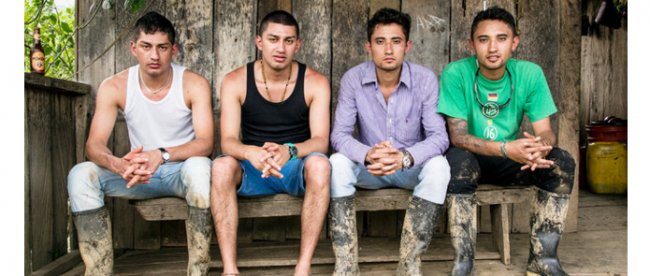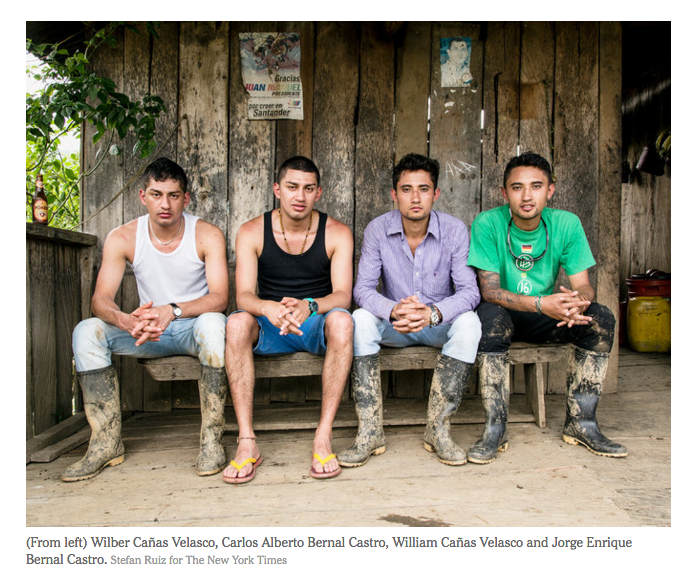The Weekender: May 6, 2016


1) “The Mixed-Up Brothers of Bogotá” (New York Times, 48 minutes, July 2015). I don’t usually put an image at the top of the Weekender, but I wanted to include a screen shot for this one because I kept referring to it as I read this. Two sets of identical twins get mixed up in the hospital at birth and grow up as two sets of fraternal twins. The story is incredible. It’s long, but every few minutes, there’s another “wow” moment. The paragraph quoted below was one of them for me, but really, the whole article is a good use of your time.
Carlos looked at Wilber, his mirror image. They took a quick peek at each other — they both shouted ‘‘Ay!’’ and turned their backs, covering their eyes, each turning red. Wilber started speaking, but Carlos was having a hard time catching what he was saying. Instead of rolling his R’s, Wilber spoke with hard D’s. The speech impediment! Carlos had one as a child but overcame it with speech therapy.
2) Sponsored (and awesome): Check out Daily Pnut to get the best in global news delivered to your inbox daily. An entertaining and informative four-minute read that will make you marginally smarter about what’s happening around the world. You can sign up here.
3) “The shelter that gives wine to alcoholics” (The Guardian, 26 minutes, April 2016).
On a grey January morning at 9.15, residents of the Oaks shelter for the homeless started lining up, coffee mugs in hand, at a yellow linoleum counter. At half past the hour, the pour began. The Oaks’ residents are hard-core alcoholics. They line up to get what most people would consider the very last thing they need: an hourly mug of alcohol.
Dorothy Young, the Oaks’ activities coordinator – a stocky, always-smiling middle-aged woman who is part cheerleader, part event planner, part warden, part bartender – stood behind the counter at a tap that dispenses cold white wine. She poured a measured amount of wine into each cup: maximum seven ounces at 7.30am for the first pour of the day, and five ounces each hour after that. Last call is 9.30pm.
[ . . . ]
The pour creates trust: here is a system that understands residents’ needs. This system loosens them from their drinking friends. It keeps them away from Listerine. Without the pour, they would stay outdoors, begging or stealing, in danger of losing their feet to frostbite. Indoors, they take their medicine, see their doctors and mental health workers, eat actual food, re-establish contact with their families. Giving free booze to homeless alcoholics sounds crazy. But it may be the key to helping them live a stable life.
4) “Fixing the American Commute” (Curbed, 24 minutes, April 2016). My commute is excessive but I enjoy it — the commuter train is a nice break from the rest of the day — but that said, commuting is generally a bad thing, from a societal perspective. Here’s a pretty great look into people who are looking for ways to make it better.
WeekenderAdUnits
5) “What Would Happen If We Just Gave People Money?” (FiveThirtyEight, 21 minutes, April 2016). For a while now, I’ve wanted to do a regular Now I Know on “MINCOME,” an experiment in a small part of Canada from the 1970s where everyone in town was given a small (but not that small) basic income. But it gets complicated very quickly and needs a more in-depth discussion. This article explores a bunch of angles. Here’s the section on MINCOME, but again, read the whole thing:
The closest research we have to how a universal basic income could work comes from a small town in Canada. From 1974 to 1979, the Canadian government partnered with the province of Manitoba to run an experiment on the idea of providing a minimum income to residents. The result was MINCOME, a guaranteed annual income offered to every eligible family in Dauphin, a prairie town of about 10,000, and smaller numbers of residents in Winnipeg and some rural communities throughout the province.3 MINCOME remains one of the most influential studies of basic income in a rich-world country.
Evelyn Forget, now an economist at the University of Manitoba, was a student in Toronto at the time. “I knew this was happening in Manitoba. I just stopped hearing about it,” she said. When Canada’s governing party changed midway through the MINCOME experiment, funding dried up and the researchers were told to archive their data for later analysis. No database was created, and the results of MINCOME were not examined.
Decades later, Forget started digging for the data. She unearthed 1,800 dusty cardboard boxes — with information on each family receiving MINCOME — at Canada’s National Archives. Forget digitized the materials and matched MINCOME records with those in the database of Canada’s universal health insurance program, which was introduced around the same time. That allowed her to compare the health of those receiving MINCOME to the health of similar people who didn’t. It resulted in a blockbuster research paper, decades in the making: “The Town With No Poverty,” published in 2011.
Families receiving MINCOME had fewer hospitalizations, accidents and injuries, Forget found. Mental health hospitalizations fell dramatically. And the high school completion rate ticked up during the years of the experiment, with 16-to-18-year-old boys, in particular, more likely to finish school. Younger adolescent girls were less likely to give birth before age 25, and when they did, they had fewer kids.
The program brought most recipients above Canada’s poverty line. And the employment effects in Dauphin were modest. “For primary earners — those with full-time jobs — there was virtually no decline” in work, Forget said. “Nobody was quitting their jobs.” Cash from the government eased families’ economic anxiety, allowing them to invest in their health and plan over a longer horizon.
6) “Teatox Party How laxative teas took over Instagram, one $250,000 celebrity endorsement at a time” (Racked, 14 minutes, April 2016). The title accurately describes what the story is about, but it is so, so weird. So weird.
Have a great weekend!

